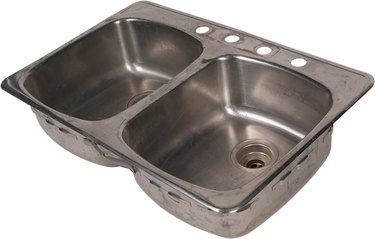
Most metal sinks are sprayed with an undercoating, but some economy models don't include this feature. The purpose of the undercoating is not to mar the sink with an ugly finish, but rather to protect both the sink and the cabinetry and decrease any annoyances. In addition to benefits, there are also hazards of older undercoatings on metal sinks you should be aware of.
Undercoating
Video of the Day
Stainless steel and other metal sinks are sprayed with an undercoating, which is latex or a rubberized material. The undercoating is a bit unsightly, as it is often black in color, and is sprayed over the noise-dampening pad that is fitted to the underside of the sink. The undercoating is only sprayed on the underside of the actual sink basin; the coating rarely makes it onto the sink lip or plumbing parts.
Video of the Day
Benefit
The undercoating helps to maintain water temperature in the sink. Without the undercoating, the sink material will cool the water faster than with the coating. The material also prevents condensation build up. When the water cools, it will collect on the underside of the sink and drip onto the wood cabinetry, sometimes causing mold. The coating prevents this condensation buildup.
Water Temperature
The nontoxic undercoating helps to absorb sound. This feature is especially important in steel or metal sinks. As plates, glasses and utensils hit the bottom of the sink, a louder "clank" would occur without the undercoating's ability to muffle some of this noise.
Hazards
Undercoated spray on metal sinks prior to the late 1970s was often made with asbestos. Repairing, removing or installing this type of undercoating can put you at risk for mesothelioma, according to the Mesothelioma Resource Center. A nontoxic latex undercoating is now used on metal sinks and has been used since the late '70s. If you suspect the undercoating was put in place before this time, don't remove or repair the undercoat and contact a plumbing specialist to test the material.